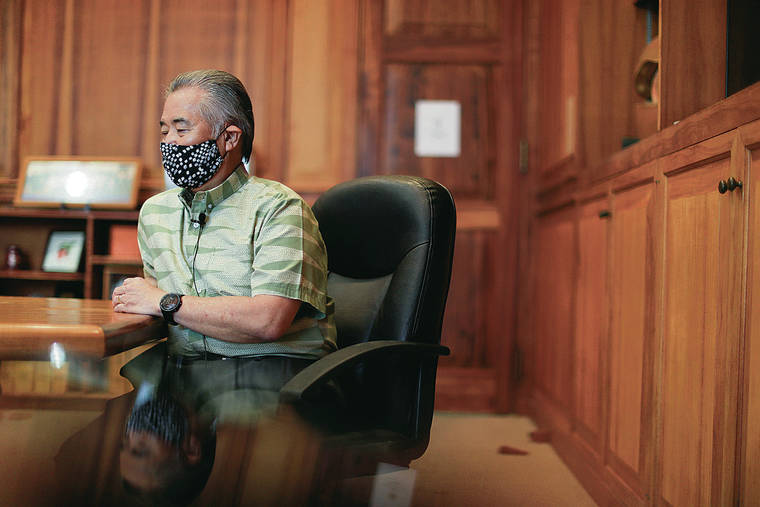Gov. David Ige hopes gloomy unemployment forecast won’t materialize


JAMM AQUINO / JAQUINO@STARADVERTISER.COM
Hawaii governor David Ige during an interview with the Star-Advertiser on Thursday at the State Capitol in Honolulu.


A report this week that Hawaii’s once-enviable low unemployment rate probably won’t be seen again until 2029 because of the COVID-19 pandemic highlights the pressure on the state to fund social service programs even in the face of a $2.3 billion budget shortfall, Gov. David Ige told the Honolulu Star-Advertiser.
“Clearly the economy has been impacted,” Ige said in an interview Thursday in his fifth-floor conference room at the state Capitol. “At the same time we know social services will be increasing: food stamps, or SNAP benefits, unemployment insurance, Medicaid expansion. So we appreciate that so many businesses have kept employees on.”
In March, before the COVID-19 pandemic began all but shutting down Hawaii’s economy, the islands enjoyed an unemployment rate of 2.4%, according to the University of Hawaii Economic Research Organization, or UHERO.
But just one month later, April’s unemployment rate skyrocketed to 23.8%, then dipped to 22.6% in May. The unemployment rate for June was 13.9%.
UHERO researchers now forecast that Hawaii will not see a return to its pre-pandemic unemployment levels until 2029, “putting the attention on social safety net programs, and job re-training and education programs.”
Ige said he hopes that ongoing efforts to contain the spread of COVID-19 — especially by having more people wear masks and practice good hygiene — will get Hawaii’s economy moving and push unemployment levels down far before 2029.
Don't miss out on what's happening!
Stay in touch with breaking news, as it happens, conveniently in your email inbox. It's FREE!
“I’m probably more optimistic than that,” Ige said.
But he acknowledged, “We’re going to have to live with COVID-19 for a while.”
In 2019 Hawaii’s 2.8% unemployment rate was the sixth best in the nation, trailing only Colorado (2.6%), New Hampshire (2.6%), Utah (2.6%), Vermont (2.3%) and North Dakota (2.3%). The U.S. average was 3.7%, according to UHERO.
Following the 18-month-long Great Recession that lasted from 2007 to 2009, Hawaii did not return to its pre-recession unemployment levels until 2014.
But the current COVID-19 pandemic is much more serious, according to UHERO, because of “protracted travel quarantines, business shutdowns and stay-at-home orders.”
Five months into the pandemic, Ige said, “people do see how things are connected.”
But he does support the planned Aug. 4 reopening of Hawaii schools, as long as the new coronavirus stays relatively controlled and everyone does their part by wearing masks, maintaining social distances and staying home when sick.
“I do understand how important it is to our community,” Ige said. “We all have a responsibility. … I do believe Aug. 4 is still a good starting date.”
The biggest challenge will be maintaining social distance and proper hygiene, especially for students who “need the most face-to-face help.”
The key will be “balancing those interests,” Ige said.
For the community at large, Ige said he worries about outdoor gatherings where hundreds of people are showing up without masks — such as last weekend’s city-sponsored events in Chinatown largely to support reopened restaurants and businesses, and Open Street Sundays on Kalakaua Avenue.
“I do have concerns about that,” he said. “Act as if you’re infected.”
And Ige is also trying to craft a message to younger adults that they need to wear masks, practice social distancing and not congregate in crowds indoors, such as in bars and restaurants. Perhaps connecting their actions to the ongoing constraints on Hawaii’s economy — and double- digit unemployment rates.
“There is a core value that all of us share about being part of the community,” Ige said. “It is a high priority and part of the local culture: ‘It’s not always just about me all the time.’”




